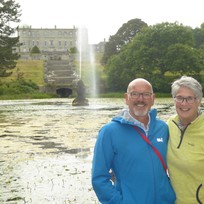( Overview
/ Two Scilly Bullocks on a Boat
Another day in port so we caught the bus into Portsmouth to the Historic Dockyard. HMS Queen Elizabeth was also in port, and being visited by friends and family. An aircraft carrier, RO8 is the lead ship of the Queen Elizabeth class of aircraft carriers and the fleet flagship of the Royal Navy.
There are a number of exhibitions in the dockyard, including one on HMS Vistory, Nelson’s flagship, which with 245 years of service is the world’s oldest vessel still in commission…
….and HMS Warrior built in 1860. Having met some friendly and helpful fellow passengers on the bus, however, we opted to visit The Mary Rose this time.
Launched in 1511 she is a carrack-type warship, and the first to be commissioned by Henry VIII. She served 33 years in several wars against France, Scotland and Brittany, but last saw action on 19th July 1545 when she led the attack on the galleys of a French invasion fleet, but sank in the Solent.
There are several theories expounding why The Mary Rose sank, but it may have been a combination of events, including modifications making her unstable, additional heavy guns increasing her draught and an inexperienced and insubordinate crew. The bronze bell, made in 1511, was rung to mark time.
The most likely explanation is she was turning about when her sails were caught by a gust of wind, she heeled and took in water through the open gunports. Tragically of over 500 sailors, only 35 survived. This toll was probably because of netting on the decks designed to prevent the enemy boarding.
The Mary Rose sank on her side, and the starboard side was covered in mud and silt, thus preserving it, until discovered by divers in 1971. Over 400 years after she sank, once the artefacts had been carefully removed, she was raised in 1982.
…and the wooden figurehead carved as a Tudor Rose, confirmed the ship was Henry the VIII’s Mary Rose.
The condition of the artefacts is amazing, and the analysis carried out on skeletons incredible. These were the Surgeon’s instruments.
Food storage. Whicker items were preserved better than some metals. Peppercorns were very valuable, and only used by the ‘upper deck’ officers for flavouring food. It seems they were a cure-all for every ailment and often used as currency.
Carpentry tools. Both the doctor’s instruments and the woodworking tools are very similar to those we know.
Hundreds of yew wood bows and poplar arrows were found. The archers’ role was to barrage the enemy before the gun ports were opened. Although there were dedicated archers, who tended to be taller and stronger than other men, all men under 60 (did they ever reach 60?) had to be proficient in archery.
A walk around Portsmouth on the Millennium or chain path. At one point finding ourselves in Gunwharf Quays shopping centre - not recommended. Fatigued, and with the prospect of a long day tomorrow, we returned to Avalon for supper and bed. With so much to do, Portsmouth is another place to revisit.






















 Sign in with Apple
Sign in with Apple  Log in with Facebook
Log in with Facebook